Looking for the top TMetric alternatives?
TMetric is a productivity tool that helps you monitor employee activity at work and boost your team’s efficiency.
However, it isn’t the perfect solution.
For starters, TMetric has no distraction management features and only offers integrations with tools like QuickBooks and Jira in its highest pricing tier.
Why settle for that when you have other tools available on the market?
In this article, we’ll cover everything you should look for in a TMetric alternative. We’ll also highlight the seven best TMetric alternatives available today.
We’ll go through each tool’s key features, pricing plans and customer ratings to help you choose the right one.
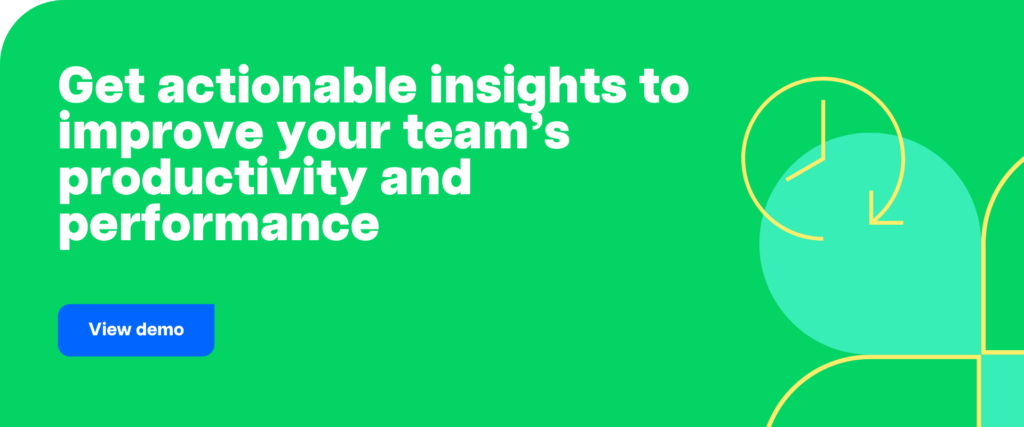
Table of Contents
- Five things you should look for in a productivity tool
- The 7 best Tmetric alternatives
- 2. Toggl
- 3. Desktime
- 4. TimeCamp
- 5. Clockify
- 6. RescueTime
- 7. Hubstaff
Let’s get started.
Five things you should look for in a productivity tool
While TMetric is a useful tool to help you monitor your employees’ productivity, it’s far from perfect.
Luckily, there are tons of alternatives you can try out instead.
But how do you pick the right one out of the hundreds of tools available?
Don’t worry.
Just consider these five things before you invest in a productivity tool, and you’re guaranteed to pick the right one:
1. Accuracy and ease of use
What’s the most important factor to consider when choosing a productivity management tool?
Its accuracy.
Your productivity tool should be able to track your employees’ working hours with split-second accuracy. This way, you’ll know exactly what your employees are up to during work hours and how much time they actually dedicate to their work.
Additionally, the app should be simple enough for your employees to understand how to use it. A complicated app will only confuse your employees and they’ll be wasting valuable time figuring out how it works.
2. Distraction management features
From social media to e-commerce, your employees can get distracted easily.
However, while these distractions eat away valuable work time, they also disrupt your employees’ workflow. So whenever they do get back to work, they’re not productive until they fall back into the flow. This can lead them to taking hours to complete even the simplest tasks!
A good productivity management tool should contain features that help distracted users get back on track before they lose focus on their work.
Look for apps that display pop-ups when users access unproductive sites and have idle-timers that stop tracking time when the user has been inactive for some time.
3. Security and privacy
Do you know why many employees hate time tracking tools?
They feel that these software invade their privacy and monitor them even after work hours.
Everyone wants to safeguard their privacy — which is why you have to be careful over which tools you invest in. If a privacy breach occurs on your part, you could end up facing a lawsuit.
Always look for tools that give your employees some kind of control over what’s being tracked. They should also be able to start or stop the program whenever they want to.
Avoid tools like keyloggers, that are often seen as invasions of privacy. Using such tools also gives your employees the notion that you don’t trust them enough, which could demotivate them.
Go for employee-friendly productivity tools and always keep them in the know about what’s being tracked. That’ll help clear up any misunderstandings and minimize the risk of legal trouble.
4. Integrations with other productivity tools
If you want to make the best use of your productivity management tool, ensure that it integrates with the other tools you use at work.
Why?
Integrating a time tracking software with other project management, communication and billing tools can help streamline your workflows.
This saves your employees from manually entering data into your time tracker when they work on other apps. Once it’s integrated, everything will sync in real-time!
5. Reporting capabilities
You may have an accurate and employee-friendly productivity tool.
But if it doesn’t show you how productive your employees are, what’s the point?
Productivity reports show you everything you need to analyze your team’s work performance. Ideally, your productivity app should track things like:
- Employee attendance.
- Time spent on unproductive tasks.
- Which apps and sites employees access during work hours.
Additionally, it’ll be helpful if the software lets you export the reports in CSV or Excel formats so that you can share them with clients for billing purposes.
The 7 best Tmetric alternatives
Here are the best productivity management tools you can use instead of TMetric:
1. Time Doctor
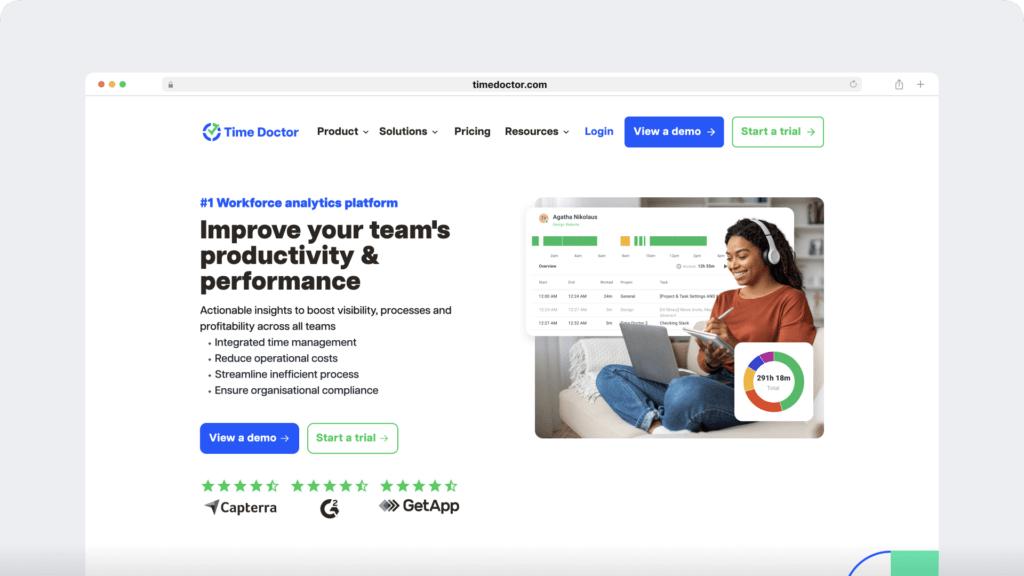
Time Doctor is a powerful workforce analytics software that’s used by major companies as well as by SMBs. Time Doctor helps teams track and boost their productivity rates quickly.
With Time Doctor, you can:
- Automatically track the time spent on tasks.
- Check which apps and websites your employees access during work hours.
- Monitor employee performance across other work tools.
- Analyze your team’s productivity with reports produced in real-time.
Key features
Here are some features that make Time Doctor the best TMetric alternative:
A. Simple time tracking
Remember, a time tracking software should be simple enough for employees to use immediately.
With Time Doctor, that’s exactly what you’ll get.
All you have to do is type in your task name and click a button to start the timer. Time Doctor will then run in the background and track your activity. Once you’re done with the task or taking a break, click on the same button and the timer stops immediately!
As your employees decide when to start and stop the timer, you won’t be running into any privacy issues.
B. Built-in inactivity tracker
Concerned that your employees are turning on the timer and taking a break during work hours?
With Time Doctor, you don’t have to worry!
Time Doctor features a built-in Inactivity Tracker that stops the timer automatically after three minutes of keyboard/mouse inactivity. Your employees will have to work actively to keep the timer running.
Note: Time Doctor doesn’t track which keys were pressed for privacy concerns. It only tracks if any keys were pressed or not.

C. Distraction management
You can’t have your staff watching Netflix when there’s work to be done, right?
Time Doctor has a Distraction Management system that shows a pop-up when a user opens any unproductive website or app during work hours. The pop-up asks users if they’re still working or not — which is usually enough to get them back on track.
For better flexibility, you can always customize which sites are classified as unproductive based on your business.

D. Powerful web and app monitorin
Time Doctor lets you track all the websites and apps your employees open during work hours. This lets you see how long your employees spent on each app, helping you identify if they were unproductive during their workday.
E. Screenshot monitoring (optional)
Time Doctor also has an optional Screenshot Monitoring feature to monitor employees’ work screens.
It takes screenshots of employee screens at random intervals so you can check them later. As Time Doctor respects your employees’ privacy, this feature can be enabled/disabled for each user.
Note: Your employees can delete any screenshot if it contains sensitive information.
F. Easy payroll management
Time Doctor’s payroll system makes it incredibly easy to pay your staff for the work done.
Time Doctor can calculate how much to pay each employee or freelancer based on the hours they work or a fixed salary. You can then pay them using PayPal, Wise, Payoneer or even with your credit card.
You can also customize:
- The payment method
- The payroll period
- The currency
- The pay rate (salary or an hourly rate)
G. Real-time reports
Time Doctor generates various powerful reports in real-time that help analyze your team members’ productivity.
Here’s a look at some of those reports:
- Timesheet report: See the total hours worked by employees during a given period.
- Timeline daily report: Shows a chronological breakdown of an employee’s daily activity.
- Projects report: Shows the project time dedicated by your team for each project.
- Time Use report: Displays a breakdown of the tasks worked on by a single employee over a given period.
- Web and app usage report: View all websites and apps opened by each employee during work hours.
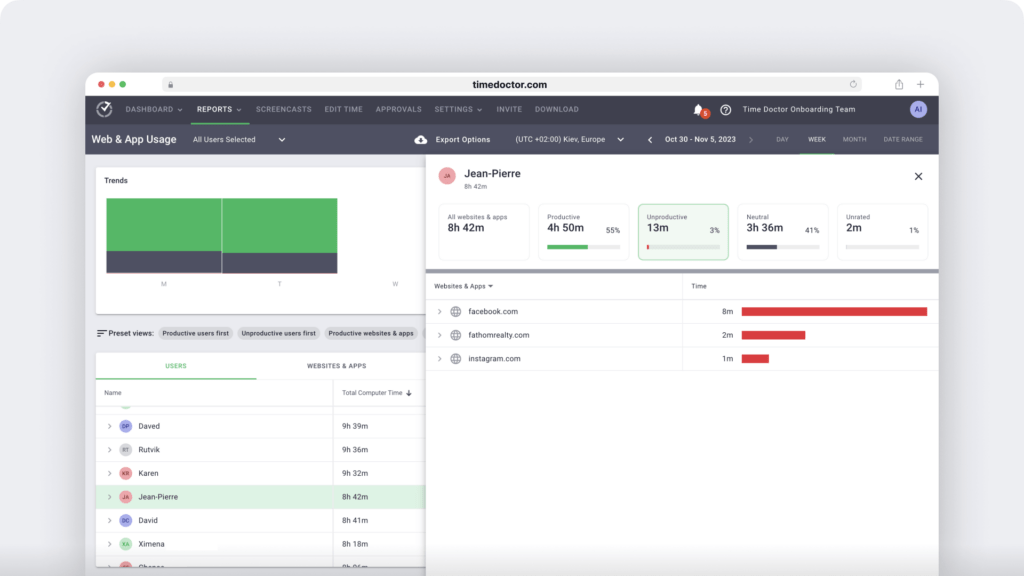
H. Integrations
Time Doctor has tons of integrations readily available. You can connect it to apps like Jira, Basecamp, Google Apps and Asana. You can also integrate Zapier to Time Doctor in order to connect with apps like QuickBooks.

Check out the complete list of integrations here.
Pros
- Simple, user-friendly interface.
- In-built inactivity tracker.
- Accurate and simple time tracking.
- Powerful offline mode to track time without the internet.
- Strict privacy and security features to protect employee information.
- Works on Linux, Windows and Mac.
- Offers great customer support.
- Track time on the go with Android and iPhone mobile apps.
- Export reports in PDF, XLS or CSV formats.
- Integrates with a range of tools, from billing apps to CRMs.
Pricing
Time Doctor starts at $7/user per month and offers volume discounts based on the number of users. You can also sign up to receive a free 14-day trial (no credit card required).
Customer ratings
- G2 – 4.3/5 (100+ reviews)
- Capterra – 4.5/5 (200+ reviews)
2. Toggl

Toggl is a cloud-based time tracking tool that allows users to track time online or offline. While it’s primarily web-based, it also has apps for iOS and Android devices. However, Toggl offers limited reports in its base pricing plan.
Key features
- Provides a one-click timer with tracking reminders.
- Integrates with project management software like Asana, Basecamp and Jira.
- Supports manual time entry and calendar integration.
- Can convert tracking data into reports.
- Great for small teams.
Pricing
Toggl has three pricing plans:
- Starter – $10/user per month
- Premium – $20/user per month
- Enterprise – Custom pricing
Customer ratings
- G2 – 4.5/5 (1000+ reviews)
- Capterra – 4.6/5 (1000+ reviews)
3. Desktime
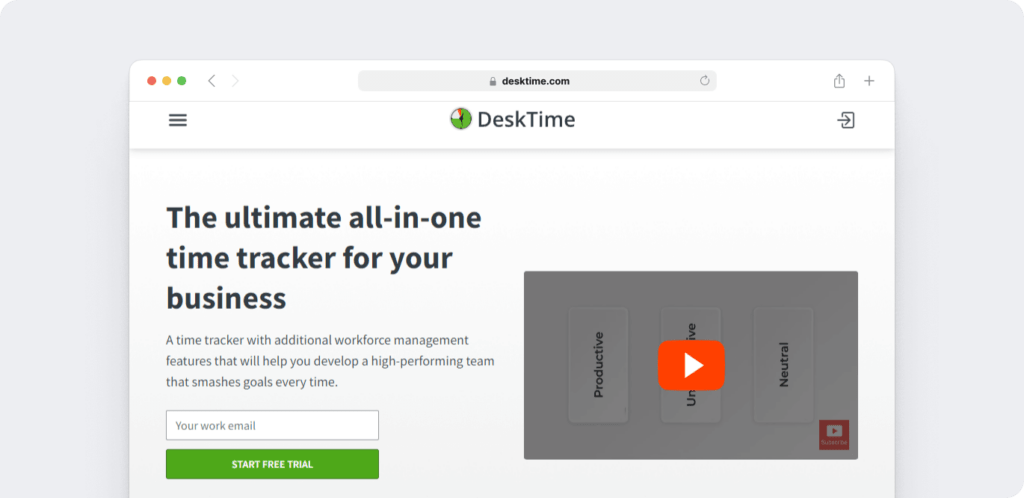
Desktime is a time-tracking tool focused on boosting employee productivity. While it’s great for businesses looking for an automated time tracker, it only has limited features in the free version.
Key features
- Automated time tracking.
- Supports website and app tracking.
- Automatic screenshots available.
- Supports offline and online time tracking.
- Integrates with task management apps like Asana and Zapier.
Pricing
Desktime has four pricing plans:
- Lite – Free
- Pro – $7/user per month
- Premium – $9/user per month
- Enterprise – $14/user per month
Customer ratings
- G2 – 4.6/5 (15 reviews)
- Capterra – 4.3/5 (100+ reviews)
4. TimeCamp

TimeCamp is a time tracking app that helps remote teams improve work efficiency and handle client invoicing.
Key features
- Can easily track billable hours.
- Offers a GPS location tracker for employees out in the field.
- Helps streamline billing with quick online invoicing.
- Provides attendance and time-off reports.
- Integrates with apps like Zoho, Wrike and Zendesk.
Pricing
TimeCamp has four pricing plans:
- Solo – Free
- Basic – $5.25/user per month
- Pro – $7.5/user per month
- Enterprise – Custom pricing
Customer ratings
- G2 – 4.7/5 (100+ reviews)
- Capterra – 4.7/5 (400+ reviews)
5. Clockify
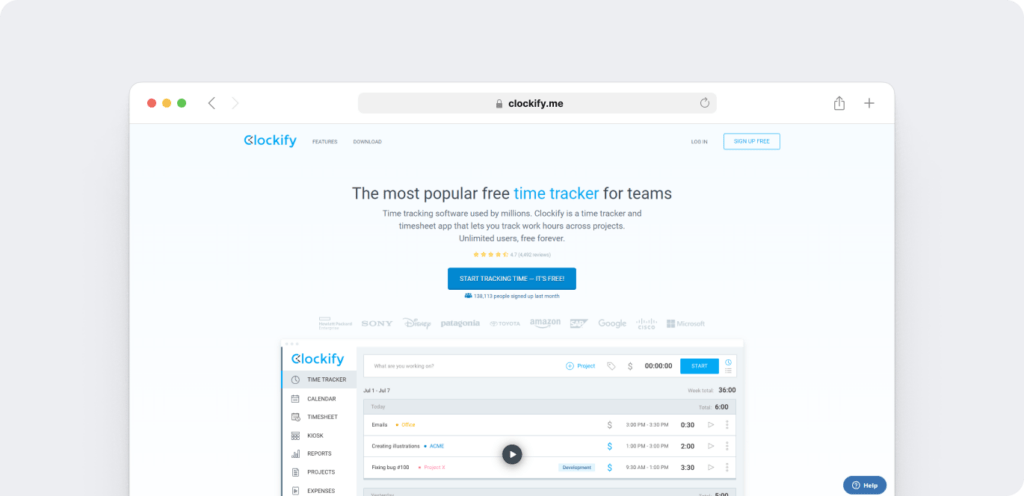
Clockify is a time tracking solution that supports unlimited tracking and unlimited users in its free version. However, it doesn’t offer screenshot or other monitoring features as it goes against their policies.
Key features
- Simple, easy to use interface.
- Supports automatic time tracking and manual time entry
- Integrates with tools like Trello and Todoist.
- Provides detailed productivity reports.
- Can customize billing rates and control access based on job role.
Pricing
Clockify has four pricing plans:
- Free
- Plus – $9.99 per month flat fee
- Premium – $29.99 per month flat fee
- Enterprise – $9.99/user per month
Customer ratings
- G2 – 4.4/5 (64 reviews)
- Capterra – 4.7/5 (1000+ reviews)
6. RescueTime
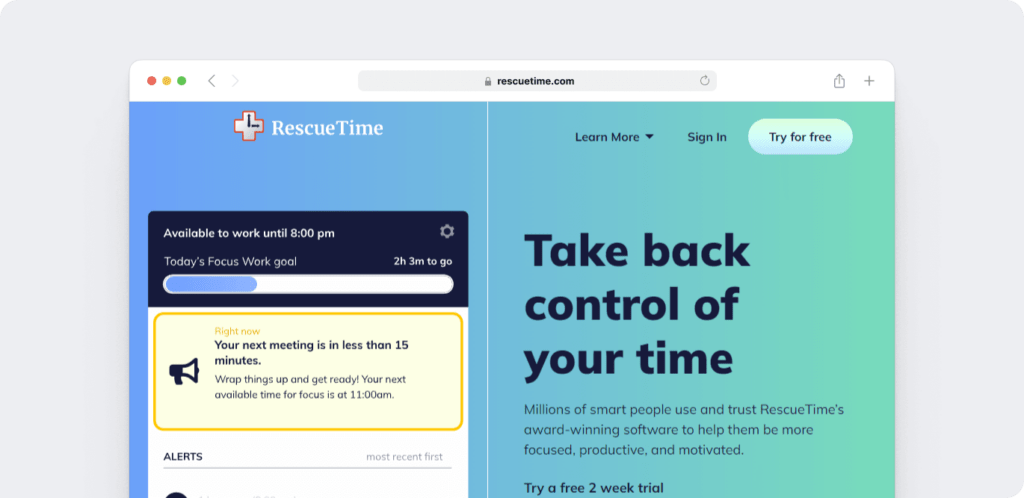
RescueTime is a web and app monitoring tool that also offers time tracking and reporting features. However, RescueTime doesn’t provide any support for billing and invoicing activities.
Key features
- Supports automatic time tracking.
- Provides detailed reports and trends on employee productivity.
- Can block distracting websites during work and set daily limits on apps and sites.
- Integrates with hundreds of apps like Slack and Google Calendar.
- Helps set productivity goals to improve your time management.
Pricing
RescueTime has two pricing plans:
- Free
- Premium – $9/user per month
Customer ratings
- G2 – 4.1/5 (65 reviews)
- Capterra – 4.6/5 (100+ reviews)
7. Hubstaff

Hubstaff is a SaaS time tracking tool with payroll and GPS tracking features. However, the payroll feature is only available with its premium pricing plans.
Key features
- Offers simple time tracking.
- Online timesheets are available to record employee work hours.
- Supports URL, screenshot and app tracking.
- Helps locate employees with GPS tracking.
- Offers detailed reports with great stats and visualizations.
Pricing
Hubstaff offers four plans:
- Free time tracking plan
- Basic – $7/user per month
- Premium – $10/user per month
- Enterprise – $20/user per month
Customer ratings
- G2 – 4.4/5 (300+ reviews)
- Capterra – 4.6/5 (1000+ reviews)
Wrapping up
While TMetric is a good employee productivity monitoring solution, it’s not perfect.
So why not consider the TMetric alternatives we covered here to get the job done?
While each tool listed in this guide is good, Time Doctor is easily the best all-in-one time tracking tool for any large or small business.


